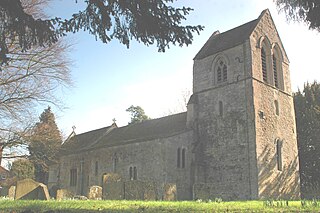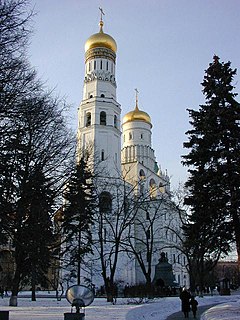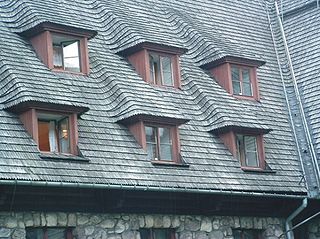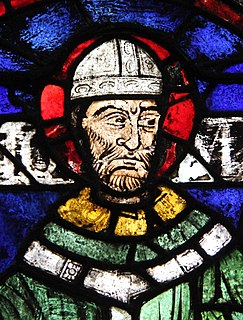
Canterbury Cathedral in Canterbury, Kent, is one of the oldest and most famous Christian structures in England. It forms part of a World Heritage Site. It is the cathedral of the Archbishop of Canterbury, currently Justin Welby, leader of the Church of England and symbolic leader of the worldwide Anglican Communion. Its formal title is the Cathedral and Metropolitical Church of Christ at Canterbury.

Minster, also known as Minster-in-Thanet, is a village and civil parish in the Thanet District of Kent, England. The village is situated to the west of Ramsgate and to the north east of Canterbury; it lies just south west of Kent International Airport and just north of the River Stour. Minster is also the "ancient capital of Thanet". At the 2011 Census the hamlet of Ebbsfleet was included.

Anglo-Saxon architecture was a period in the history of architecture in England, and parts of Wales, from the mid-5th century until the Norman Conquest of 1066. Anglo-Saxon secular buildings in Britain were generally simple, constructed mainly using timber with thatch for roofing. No universally accepted example survives above ground.

Ickford is a village and civil parish in the Aylesbury Vale district of Buckinghamshire, England. It is on the boundary with Oxfordshire, about 4 miles (6.4 km) west of the market town of Thame.

St Michael's Church, St Albans is a Church of England parish church in St Albans, Hertfordshire, England. Much of the building is late 10th or early 11th century, making it the most significant surviving Anglo-Saxon building in the county. It is located near the centre of Roman Verulamium to the west of the modern city.

Woodeaton or Wood Eaton is a village and civil parish about 4 miles (6.4 km) northeast of Oxford, England.

St Mary's Priory Church, Deerhurst, is the Church of England parish church of Deerhurst, Gloucestershire, England. Much of the church is Anglo-Saxon. It was built in the 8th century, when Deerhurst was part of the Anglo-Saxon kingdom of Mercia. It is contemporary with the Carolingian Renaissance on mainland Europe, which may have influenced it.

St Peter's Church is the parish church of Prestbury, Cheshire, England. It is probably the fourth church on the site. The third, the Norman Chapel, stands in the churchyard. The church is recorded in the National Heritage List for England as a designated Grade I listed building. The Norman Chapel, the lychgate and west wall, the Hearse House, and the sundial in the churchyard are listed at Grade II. It is a Church of England parish church in the diocese of Chester, the archdeaconry of Macclesfield and the deanery of Macclesfield.

Stodmarsh is a small village 5 miles to the east of Canterbury in east Kent, England, overlooking the valley of the River Stour.

St Peter's Church, Monkwearmouth is the parish church of Monkwearmouth in Sunderland, Tyne and Wear, England. It is one of three churches in the Parish of Monkwearmouth. The others are All Saints' Church, Monkwearmouth and St Andrew's Church, Roker.

Walsoken is a settlement and civil parish in Norfolk, England. and conjoined as a suburb at the northeast of the town of Wisbech.

The Parish Church of Saint Mary, North Leigh is the Church of England parish church of North Leigh, a village about 3 miles (5 km) northeast of Witney in Oxfordshire.

Holy Trinity Church is a redundant Anglican church on Low Lane in the village of Wensley, North Yorkshire, England. The building is recorded in the National Heritage List for England as a designated Grade I listed building, and is under the care of the Churches Conservation Trust. Alec Clifton-Taylor includes the church in his list of 'best' English parish churches.

The Church of St Mary the Virgin is a redundant Anglican church in the small town of Fordwich, Kent, England. It is recorded in the National Heritage List for England as a designated Grade I listed building, and is under the care of the Churches Conservation Trust. The church stands near to the centre of Fordwich, some 3 miles (5 km) northeast of Canterbury.

St James' Church is in the village of Altham, Lancashire, England. It is an active Anglican parish church in the deanery of Accrington, the archdeaconry of Blackburn, and the diocese of Blackburn. Its benefice has been united with that of All Saints, Clayton-le-Moors. The church is recorded in the National Heritage List for England as a designated Grade II* listed building.

St Giles' Church is in the hamlet of Barrow, Shropshire, England. It is an active Anglican parish church in the deanery of Telford Severn Gorge, the archdeaconry of Ludlow, and the diocese of Hereford. Its benefice is united with those of All Saints, Broseley, St Mary, Jackfield, St Bartholomew, Benthall, and St Leonard, Linley. The church is recorded in the National Heritage List for England as a designated Grade I listed building. It is one of the earliest surviving churches in Shropshire, and contains the county's only Saxon chancel.

St Mary’s is an Anglican church in Hadleigh, Suffolk. It is an active parish church in the Diocese of St Edmundsbury and Ipswich and the archdeaconry of Ipswich. Its earliest parts date from medieval times.

St Eanswith's Church is a Grade II* listed Anglican church in the village of Brenzett, Kent, about 7 miles (11 km) north-east of Rye, East Sussex. A church was originally built on this site in the 7th century; the present building dates from the 12th century and has later modifications.

St John the Baptist's Church is an Anglican church in the village of Mayfield, Staffordshire, England. It is a Grade I listed building. The core is a Norman church; it was extended in the early 14th century, and the tower built in 1515.

St Mary and St Eanswythe’s Church is a Grade II* listed Anglican church in Folkestone, Kent, situated not far from cliffs overlooking the English Channel. Parts of the building date from the 13th century, but it was largely rebuilt in the 19th century. It is unusual in having a central tower.






























